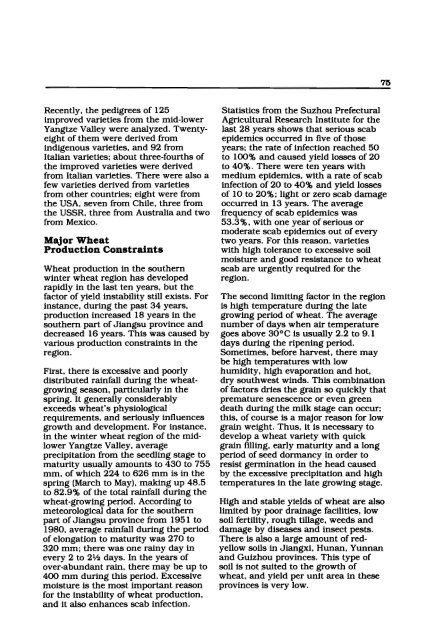the Symposium on Wheats for More Tropical Environments - cimmyt
the Symposium on Wheats for More Tropical Environments - cimmyt
the Symposium on Wheats for More Tropical Environments - cimmyt
- No tags were found...
Create successful ePaper yourself
Turn your PDF publications into a flip-book with our unique Google optimized e-Paper software.
75Recently, <str<strong>on</strong>g>the</str<strong>on</strong>g> pedigrees of 125improved varieties from <str<strong>on</strong>g>the</str<strong>on</strong>g> mid-lowerYangtze Valley were analyzed. Twentyeightof <str<strong>on</strong>g>the</str<strong>on</strong>g>m were derived fromindigenous varieties, and 92 fromItalian varieties; about three-fourths of<str<strong>on</strong>g>the</str<strong>on</strong>g> improved varieties were derivedfrom Italian varieties. There were also afew varieties derived from varietiesfrom o<str<strong>on</strong>g>the</str<strong>on</strong>g>r countries; eight were from<str<strong>on</strong>g>the</str<strong>on</strong>g> USA, seven from Chile, three from<str<strong>on</strong>g>the</str<strong>on</strong>g> USSR, three from Australia and twofrom Mexico.Major WheatProducti<strong>on</strong> C<strong>on</strong>straintsWheat producti<strong>on</strong> in <str<strong>on</strong>g>the</str<strong>on</strong>g> sou<str<strong>on</strong>g>the</str<strong>on</strong>g>rnwinter wheat regi<strong>on</strong> has developedrapidly in <str<strong>on</strong>g>the</str<strong>on</strong>g> last ten years, but <str<strong>on</strong>g>the</str<strong>on</strong>g>factor of yield instability still exists. Forinstance, during <str<strong>on</strong>g>the</str<strong>on</strong>g> past 34 years,producti<strong>on</strong> increased 18 years in <str<strong>on</strong>g>the</str<strong>on</strong>g>sou<str<strong>on</strong>g>the</str<strong>on</strong>g>rn part of Jiangsu province anddecreased 16 years. This was caused byvarious producti<strong>on</strong> c<strong>on</strong>straints in <str<strong>on</strong>g>the</str<strong>on</strong>g>regi<strong>on</strong>.First, <str<strong>on</strong>g>the</str<strong>on</strong>g>re is excessive and poorlydistributed rainfall dUring <str<strong>on</strong>g>the</str<strong>on</strong>g> wheatgrowingseas<strong>on</strong>, particularly in <str<strong>on</strong>g>the</str<strong>on</strong>g>spring. It generally c<strong>on</strong>siderablyexceeds wheat's physiologicalrequirements. and seriously influencesgrowth and development. For instance,in <str<strong>on</strong>g>the</str<strong>on</strong>g> winter wheat regi<strong>on</strong> of <str<strong>on</strong>g>the</str<strong>on</strong>g> midlowerYangtze Valley, averageprecipitati<strong>on</strong> from <str<strong>on</strong>g>the</str<strong>on</strong>g> seedling stage tomaturity us.ually amounts to 430 to 755mm, of which 224 to 626 mm is in <str<strong>on</strong>g>the</str<strong>on</strong>g>spring (March to May), making up 48.5to 82.9% of <str<strong>on</strong>g>the</str<strong>on</strong>g> total rainfall during <str<strong>on</strong>g>the</str<strong>on</strong>g>wheat-growing period. According tometeorological data <strong>for</strong> <str<strong>on</strong>g>the</str<strong>on</strong>g> sou<str<strong>on</strong>g>the</str<strong>on</strong>g>rnpart of Jiangsu province from 1951 to1980, average rainfall dUring <str<strong>on</strong>g>the</str<strong>on</strong>g> periodof el<strong>on</strong>gati<strong>on</strong> to maturity was 270 to320 mm; <str<strong>on</strong>g>the</str<strong>on</strong>g>re was <strong>on</strong>e rainy day inevery 2 to 2V2 days. In <str<strong>on</strong>g>the</str<strong>on</strong>g> years ofover-abundant rain, <str<strong>on</strong>g>the</str<strong>on</strong>g>re may be up to400 mm during this period. Excessivemoisture is <str<strong>on</strong>g>the</str<strong>on</strong>g> most important reas<strong>on</strong><strong>for</strong> <str<strong>on</strong>g>the</str<strong>on</strong>g> instability of wheat producti<strong>on</strong>,and it also enhances scab infecti<strong>on</strong>.Statistics from <str<strong>on</strong>g>the</str<strong>on</strong>g> Suzhou PrefecturalAgricultural Research Institute <strong>for</strong> <str<strong>on</strong>g>the</str<strong>on</strong>g>last 28 years shows that serious scabepidemics occurred in five of thoseyears; <str<strong>on</strong>g>the</str<strong>on</strong>g> rate of infecti<strong>on</strong> reached 50to 100% and caused yield losses of 20to 40%. There were ten years withmedium epidemics, with a rate of scabinfecti<strong>on</strong> of 20 to 40% and yield lossesof 10 to 20%; light or zero scab damageoccurred in 13 years. The averagefrequency of scab epidemics was53.3%, with <strong>on</strong>e year of serious ormoderate scab epidemics out of everytwo years. For this reas<strong>on</strong>. varietieswith high tolerance to excessive soilmoisture and good resistance to wheatscab are urgently reqUired <strong>for</strong> <str<strong>on</strong>g>the</str<strong>on</strong>g>regi<strong>on</strong>.The sec<strong>on</strong>d limiting factor in <str<strong>on</strong>g>the</str<strong>on</strong>g> regi<strong>on</strong>is high temperature dUring <str<strong>on</strong>g>the</str<strong>on</strong>g> lategrowing period of wheat. The averagenumber of days when air temperaturegoes above 30°C is usually 2.2 to 9.1days dUring <str<strong>on</strong>g>the</str<strong>on</strong>g> ripening period.Sometimes, be<strong>for</strong>e harvest, <str<strong>on</strong>g>the</str<strong>on</strong>g>re maybe high temperatures with lowhumidity, high evaporati<strong>on</strong> and hot,dry southwest winds. This combinati<strong>on</strong>of factors dries <str<strong>on</strong>g>the</str<strong>on</strong>g> grain so qUickly thatpremature senescence or even greendeath dUring <str<strong>on</strong>g>the</str<strong>on</strong>g> milk stage can occur;this, of course is a major reas<strong>on</strong> <strong>for</strong> lowgrain weight. Thus. it is necessary todevelop a wheat variety with quickgrain filling, early maturity and a l<strong>on</strong>gperiod of seed dormancy in order toresist germinati<strong>on</strong> in <str<strong>on</strong>g>the</str<strong>on</strong>g> head causedby <str<strong>on</strong>g>the</str<strong>on</strong>g> excessive precipitati<strong>on</strong> and hightemperatures in <str<strong>on</strong>g>the</str<strong>on</strong>g> late growing stage.High and stable yields of wheat are alsolimited by poor drainage facilities, lowsoil fertility, rough tillage, weeds anddamage by diseases and insect pests.There is also a large amount of redyellowsoils in Jiangxi, Hunan, Yunnanand Guizhou provinces. This type ofsoil is not suited to <str<strong>on</strong>g>the</str<strong>on</strong>g> growth ofwheat, and yield per unit area in <str<strong>on</strong>g>the</str<strong>on</strong>g>seprovinces is very low.

















